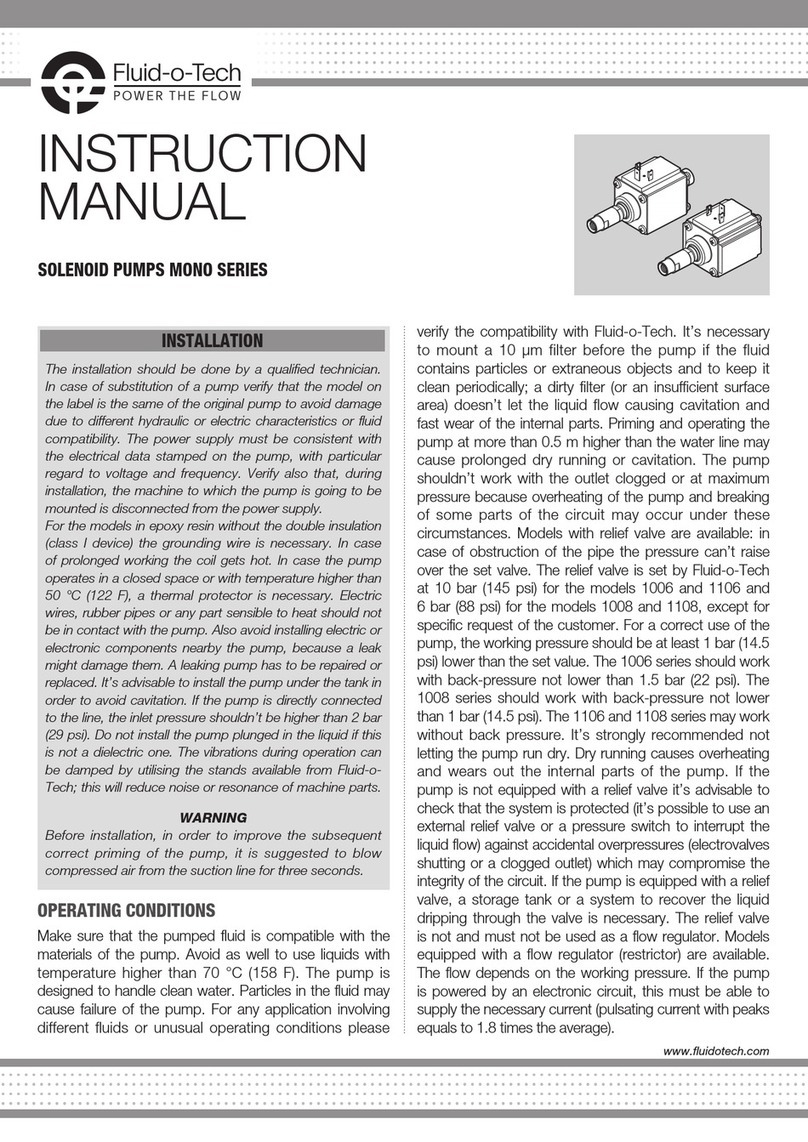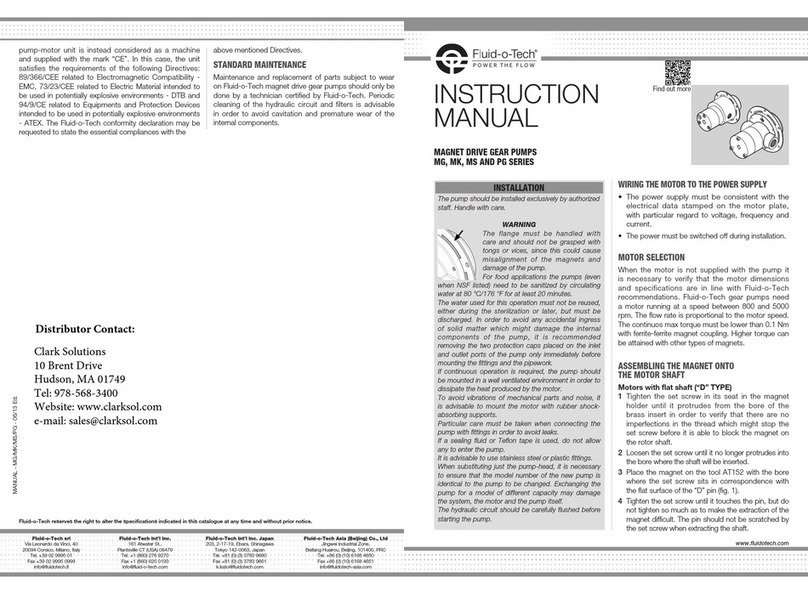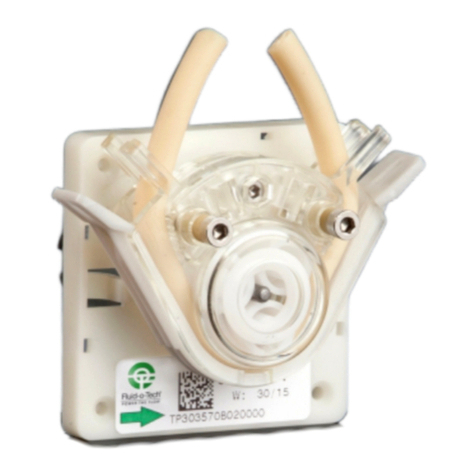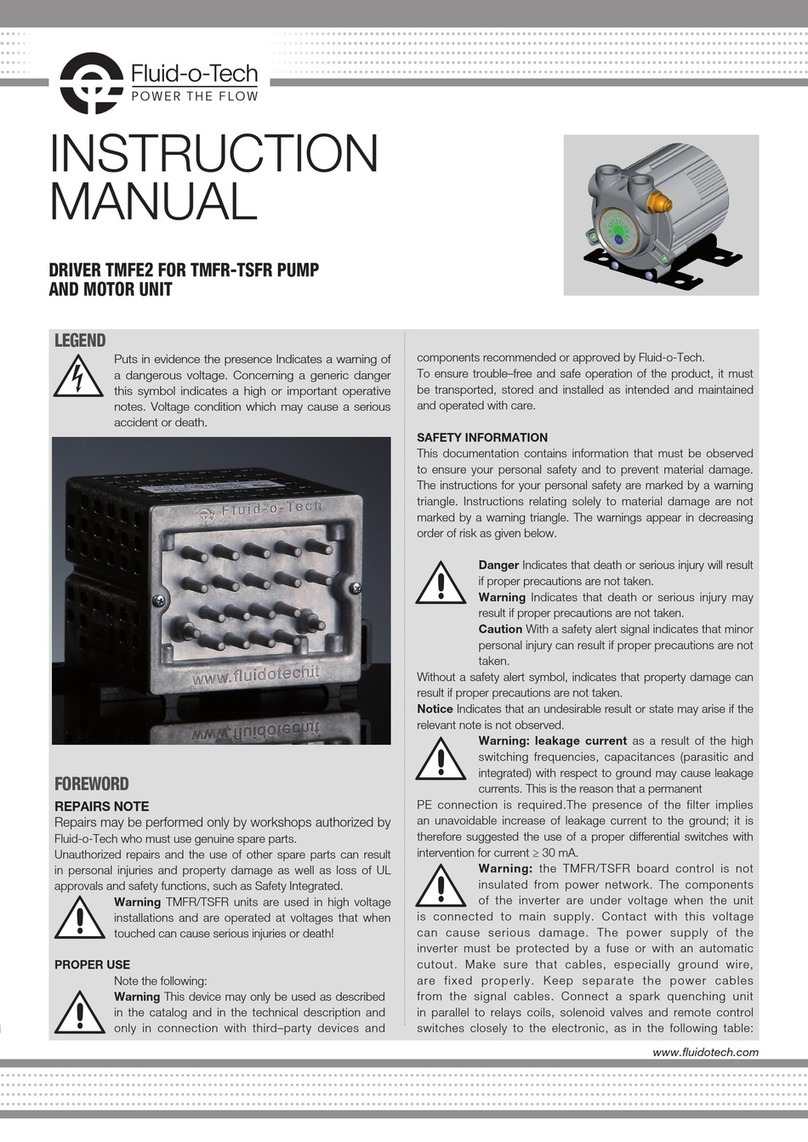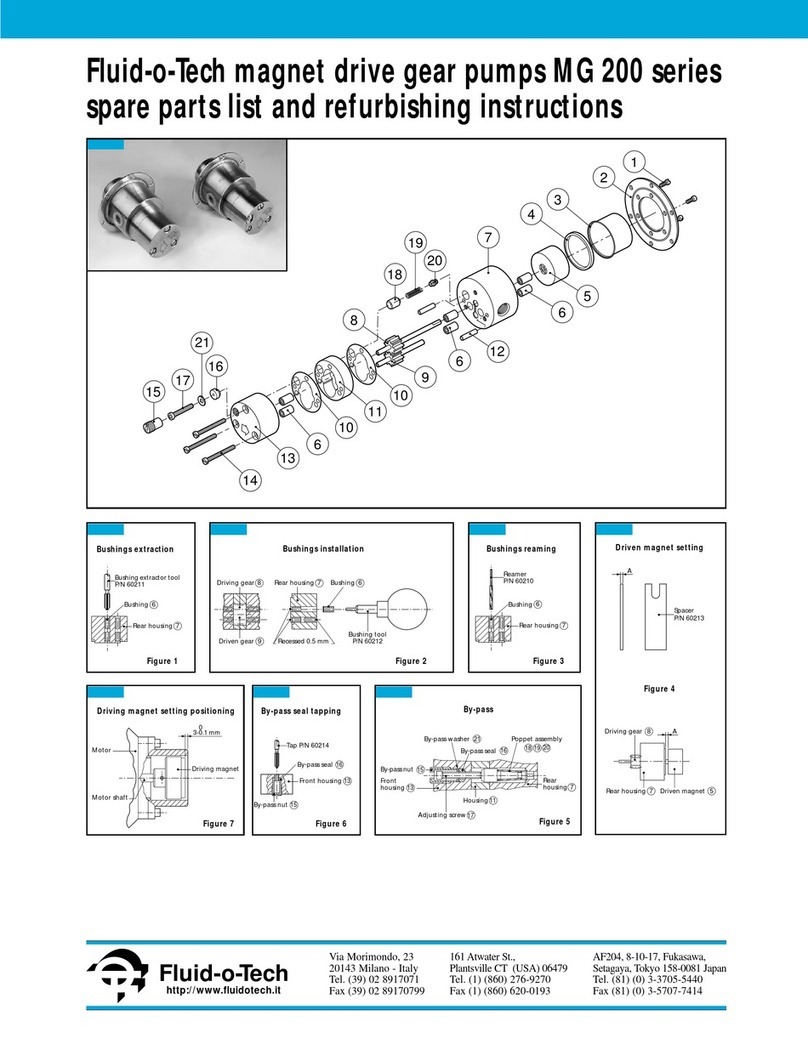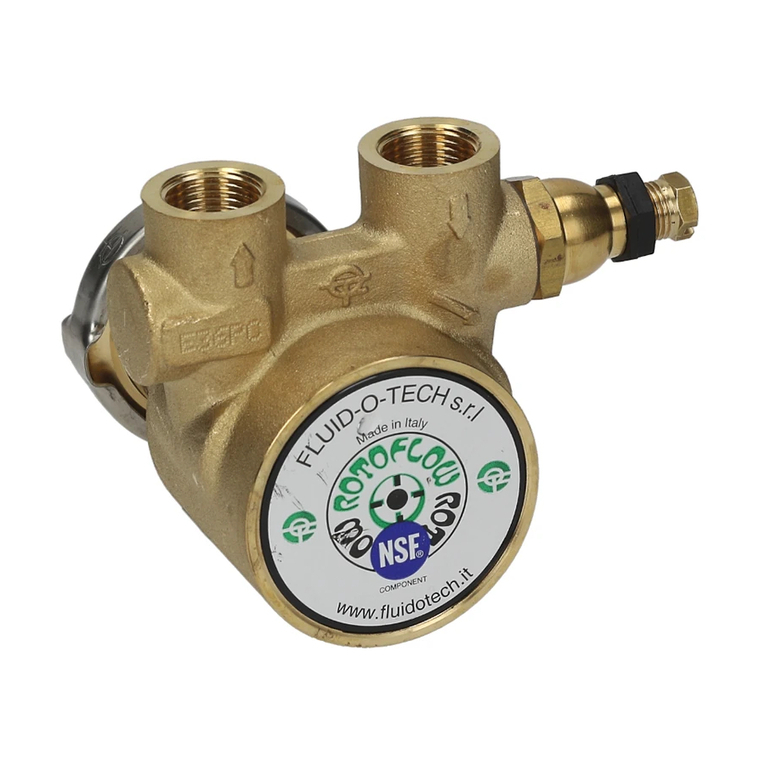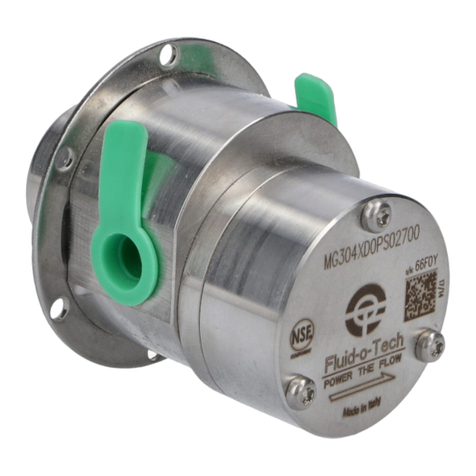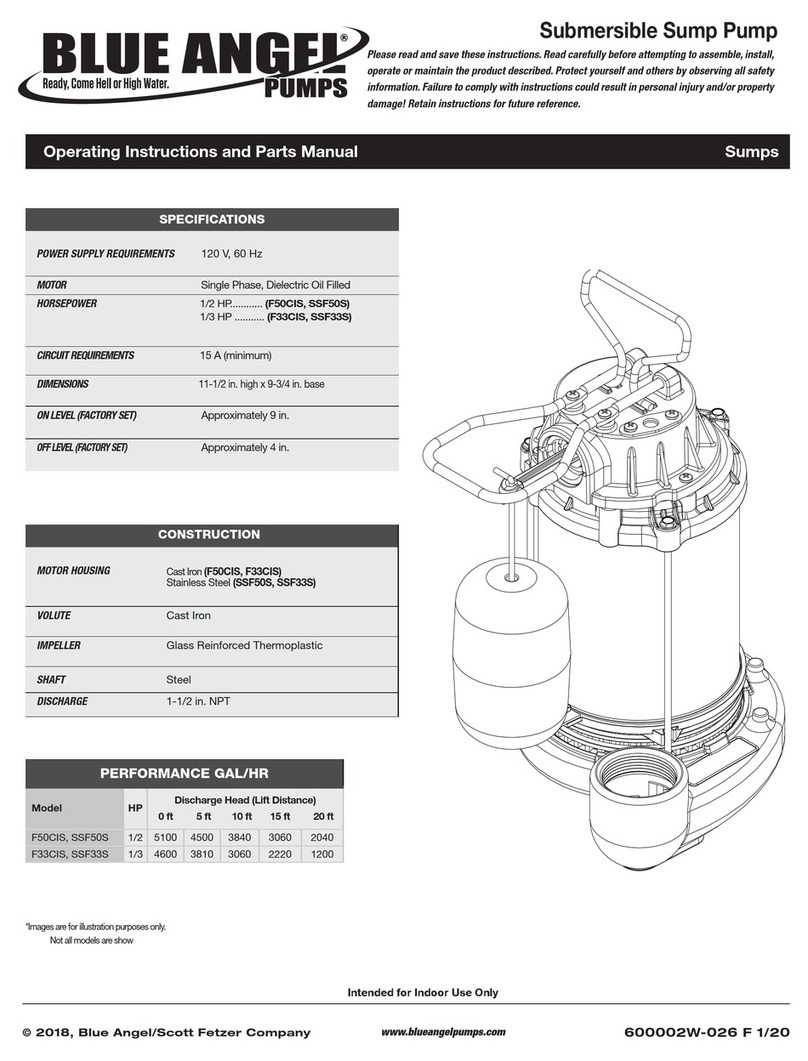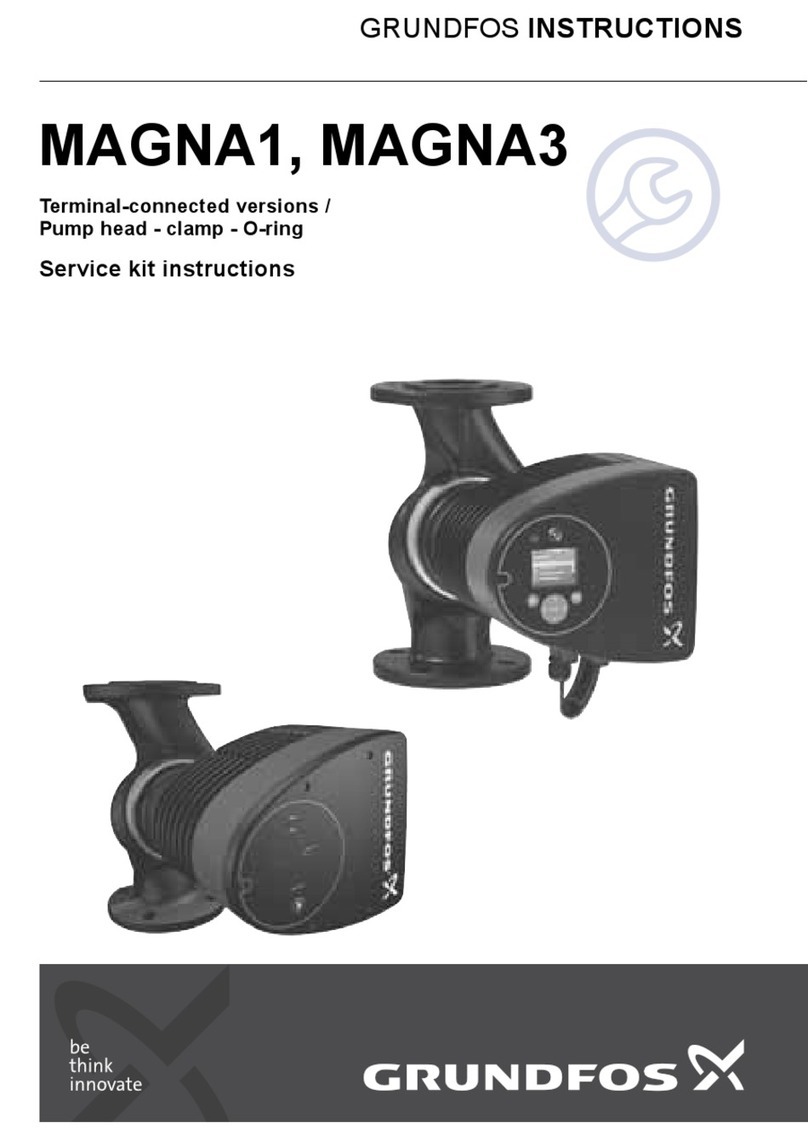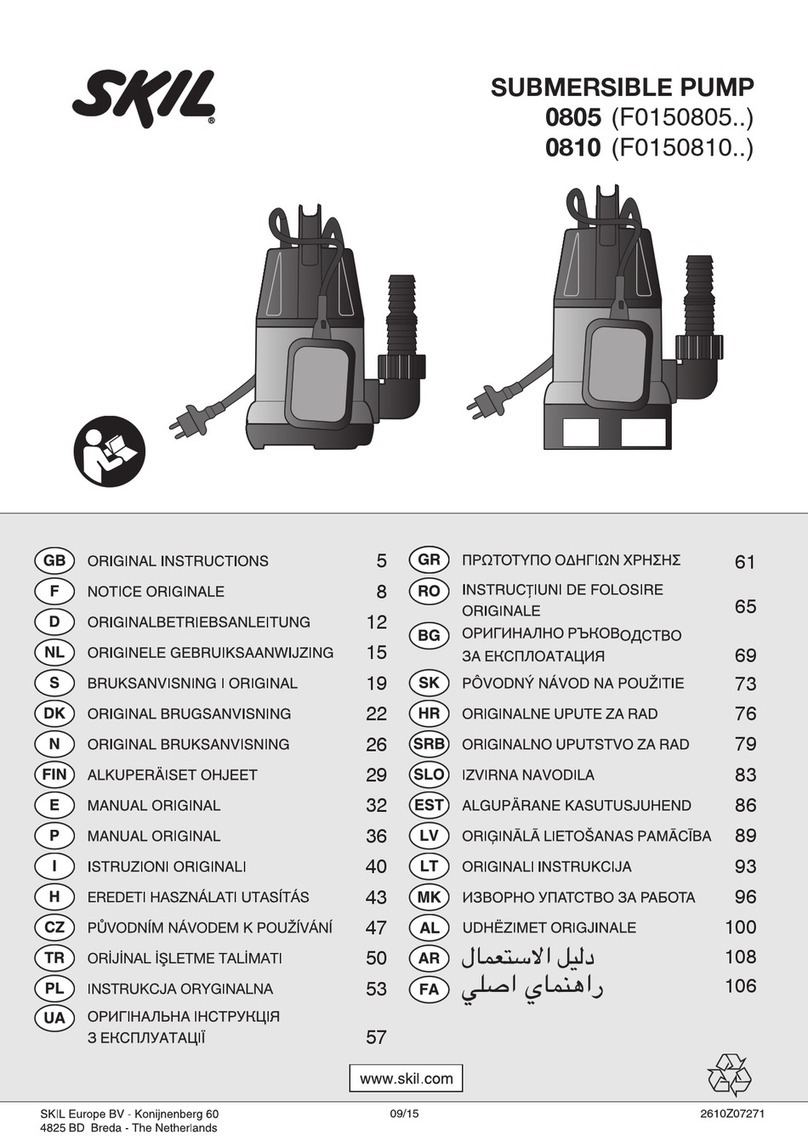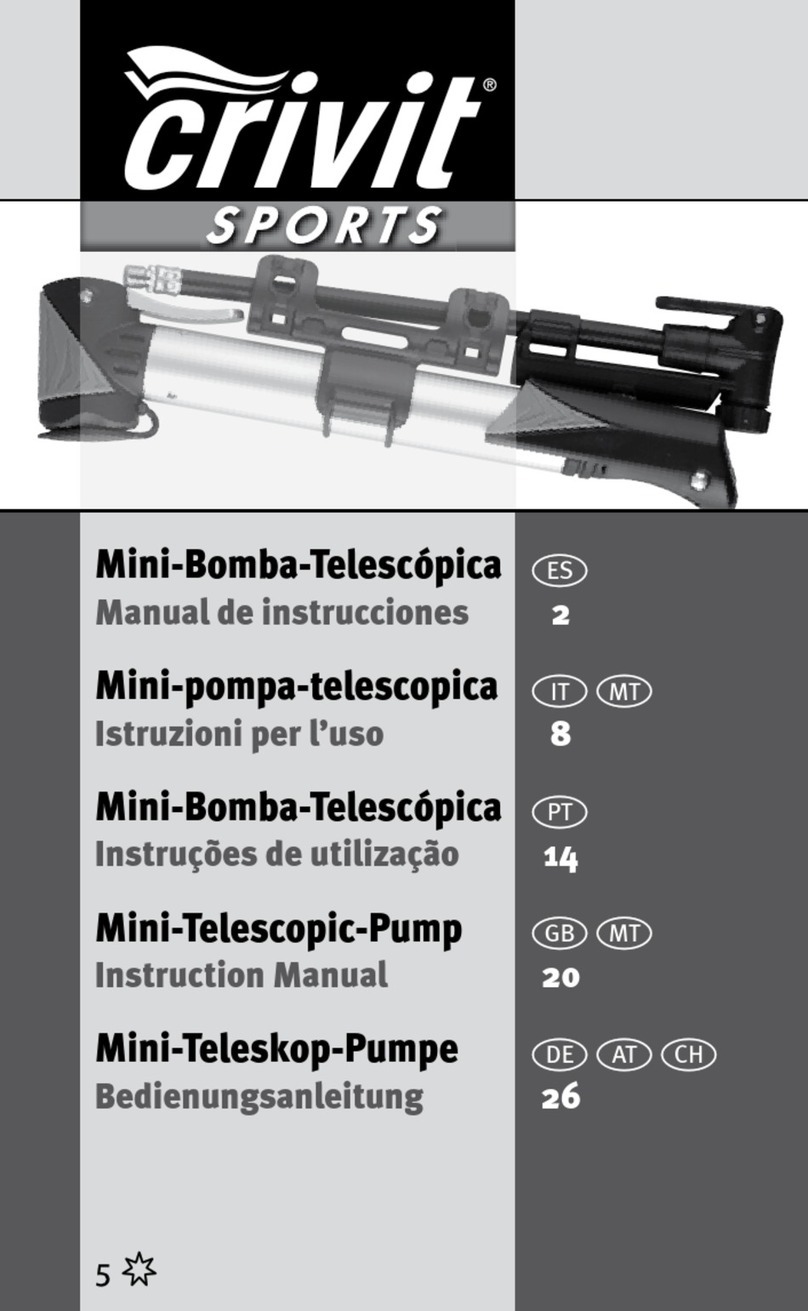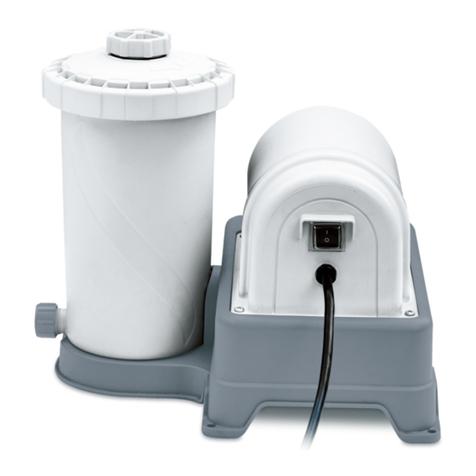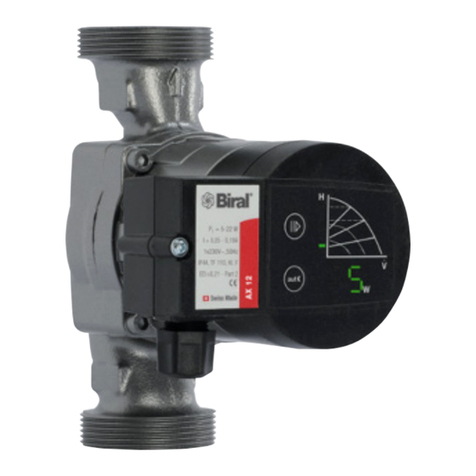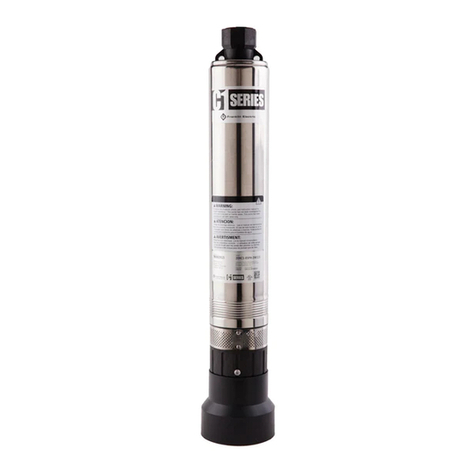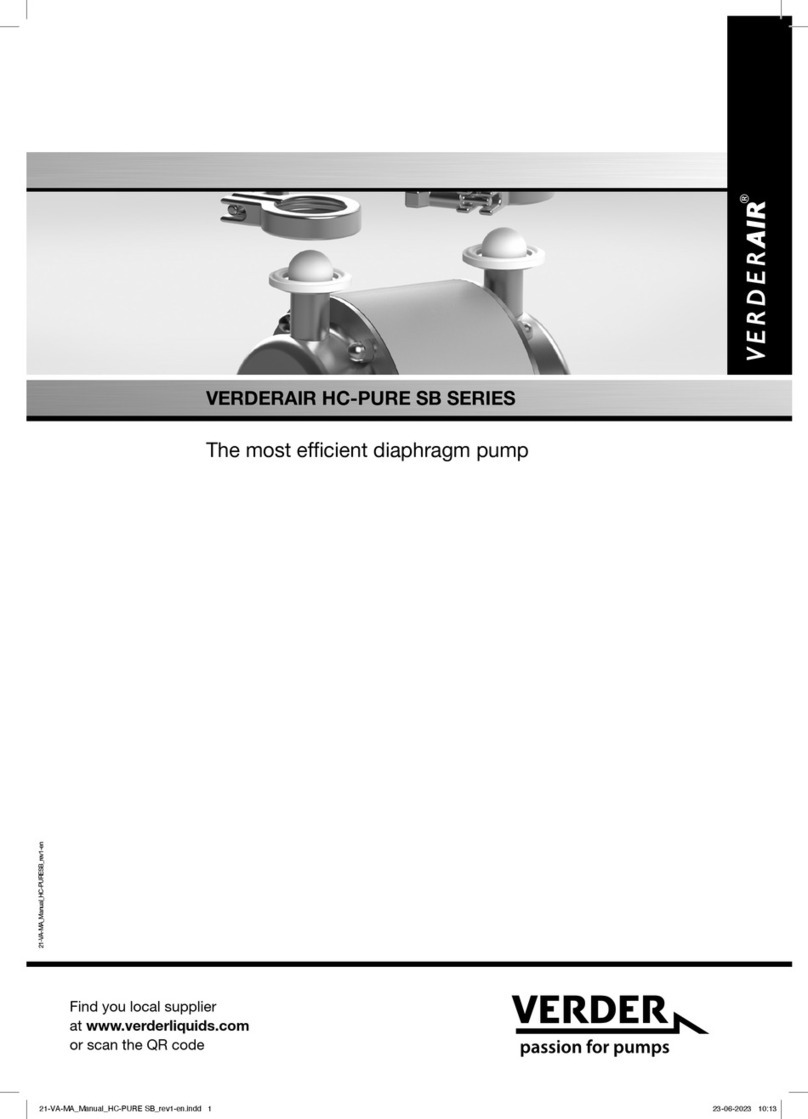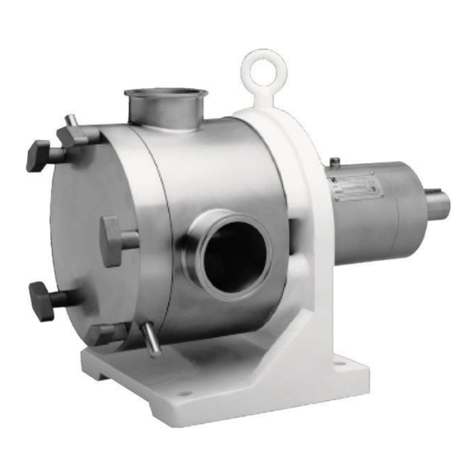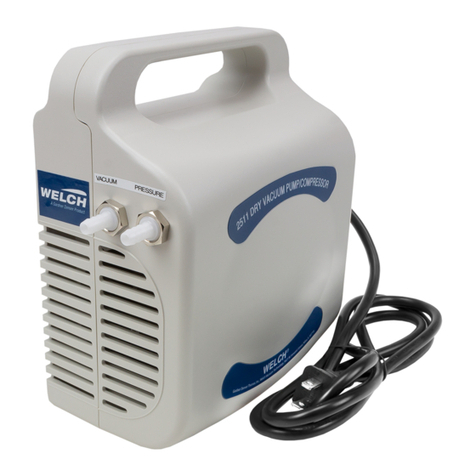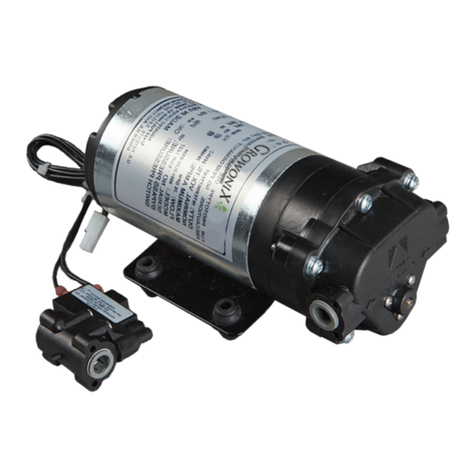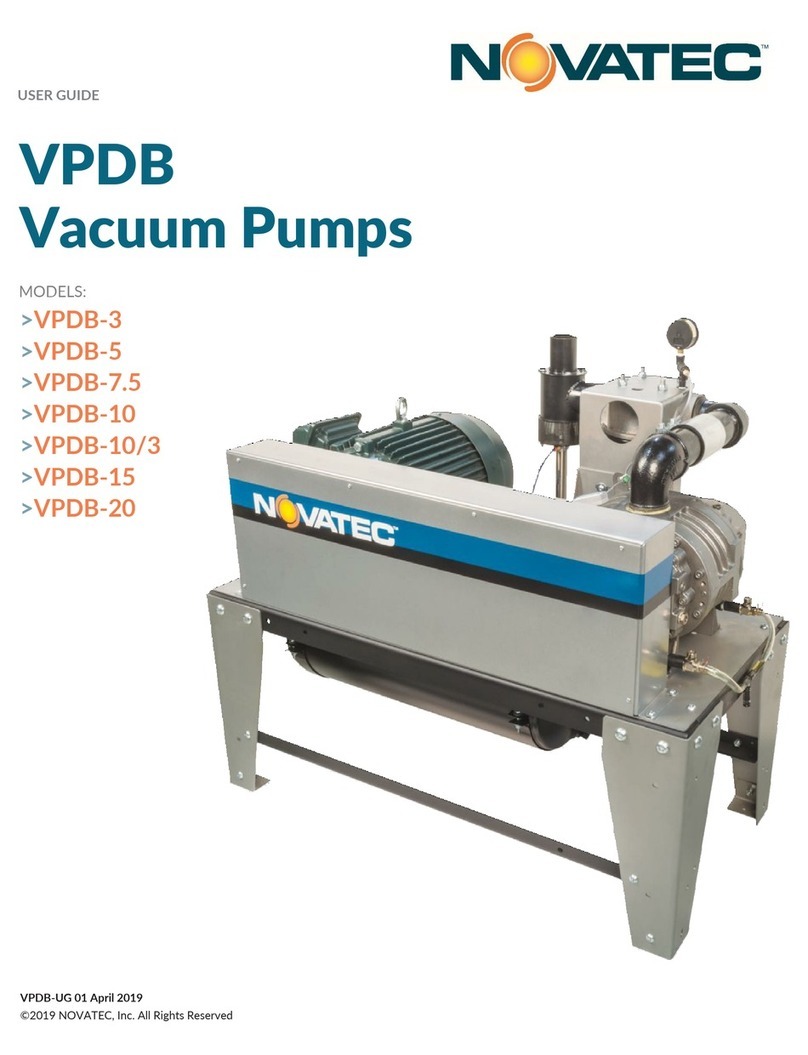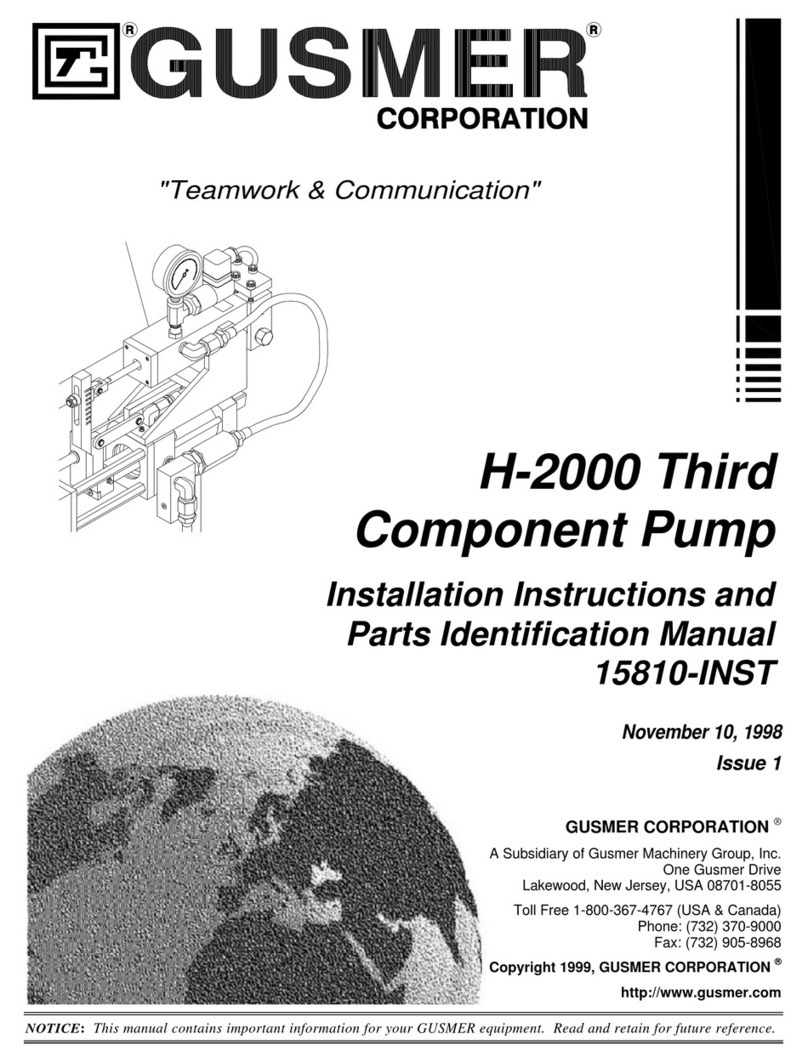
OPERATING CONDITIONS
Make sure the pumped fluid is compatible with the materials of the
pump. Fluid-o-Tech’s gear pumps are designed to work only with
clean fluids and are tested with water at ambient temperature.
Any other fluid and/or operating condition must be verified and
approved by the end customer under the actual conditions of
use. Make sure the maximum temperature of the liquid and the
environment are compatible with the model used. It is necessary
to use – especially on the pump’s intake duct – pipes with an inner
diameter adequately sized in relation to the pump’s flow rate. This
precaution prevents the risk of cavitation and resulting damage on
the pump.
The sum of the inlet and outlet pressure must not exceed the
maximum system pressure indicated in the catalogue.
We recommend you adapt the size of the pipe in relation to the
delivery duct for pressure values at least 1.5 times the maximum
pressure of the system.
The pumped fluids must not contain solid suspended particles.
Before mounting the pump, we recommend installing a 10 µm
filter with a surface area large enough in order to prevent excessive
pressure drops in the circuit. Although occasional, particles larger
than 10 µm cause premature wear of internal components. It is
also important to periodically check the state of the cartridge and
the filter. To monitor the filter we recommend installing a pressure-
vacuum gauge after the filter. If the vacuum increases by more than
0.1 bar, the cartridge must be cleaned or replaced.
Although DGD and DGM gear pumps are self-priming pumps, they
should operate with a positive suction head. Indeed dry running
causes premature wear of the internal components of the pump.
If the water supply system operates with low pressure or no flow
rate, it is necessary to install a pressure switch before the pump to
turn off the motor. It is also necessary also protect the system from
accidental excessive pressure with safety devices such as a bypass
valve or a pressure switch connected to the motor.
The solenoid valves must not be installed in the circuit but, if
necessary, must only be installed on the delivery section of the
pump. We strongly recommend against installing the solenoid valves
before the pump. To avoid pressure peaks it is necessary to close
the solenoid valve only after the pump has stopped, then wait a
few seconds after the motor has been turned off to allow it stop
completely. The size of the inner diameter of the solenoid valve’s
duct must be adequate to the pump’s flow rate. The maximum
pressure depends on the unit model used.
Outside the values specified in the charts on page 4 the unit could
stop or the coupling could fail (DGM only). To re-fit the coupling it
is necessary to disconnect the motor’s power supply and wait till it
stops before restarting it.
STANDARD MAINTENANCE
Maintenance and replacement of parts subject to wear of
Fluid-o-Tech’s DGD and DGM units must be performed
by qualified technical staff. We recommend cleaning
the circuit and filters periodically to prevent cavitation
and wear of the internal components of the pump.
WARRANTY TERMS AND CONDITIONS
Every pump comes with a 12-month warranty valid from the date
of manufacture indicated on the label, plus a period of 3 months to
cover transport and storage. This period shall not exceed 15 months
from the date of the original invoice under any circumstances.
Fluid-o-Tech can only for held liable for the repair or replacement of
faulty parts returned on a DDP base, provided that our inspection
reveals that the part(s) in question was faulty at the time of sale.
The warranty is voided if:
• Themounting/useinstructionshavebeendisregarded.
• The pump was removed by a technician not authorized by
Fluid-o-Tech and/or repaired with non-original parts.
• Thepumpoperatedwithnowaterorundercavitationconditions.
• Solidforeignparticlesarefoundinthepump.
• Clearsignsofexcessivepressurearedetected.
• Thepumphasbeenusedforanapplicationitwasnotintended
for, where the operating conditions and/or the pumped liquid are
incompatible with the pump itself and therefore such application
had not been approved by Fluid-o-Tech.
• Thewarrantydoesnotcoverthenormalwearofthepump.
The repair or replacement of faulty parts during the warranty period
will not extend the original period of the warranty.
CERTIFICATIONS
Some gear pump models of the DGD and DGM series are NSF
certified for use with food-grade fluids. The CE label can be applied
only on motor-pump units. The label cannot be applied on the pump
alone in accordance with the applicable EC standard.
In this case the group meets the requirements of the following
directives: 89/366/EEC concerning Electromagnetic Compatibility
– EMC, 73/23/EEC concerning electrical equipment for use in
potentially explosive atmospheres – DTB and 94/9/EC on
Equipment and Safety devices intended for use in potentially
explosive atmospheres – ATEX. Fluid-o-Tech is able to provide
a declaration of conformity to certify compliance with the above
mentioned Directives.
We recommend a minimum safety factor of 1.5. Protect the
DGM and DGD units from frost. Freezing could permanently
damage the pump and pipes.
7The DGD and DGM units are low voltage devices, though it is
still necessary to comply with the relevant safety standards.
The installer is responsible for making sure current regulations,
closely associated with the final application, are complied with.
8Insert a filter of a suitable size upstream of the pump to prevent
solid particles with a diameter greater than 10μm from entering
inside. The surface of the filter must be sized in relation to the
flow rate and type of circuit in order to prevent excessive drops
in pressure. This filter must be cleaned periodically.
9If the units are connected in circuits fitted with solenoid valves,
make sure these always act with a certain delay after the motor
shuts down. Solenoid valves with early or simultaneous closure
can cause excessive pressure or cavitation and damage the
unit and/or the hydraulic circuit.
10 We recommend inserting a fuse of a suitable size in the unit’s
power supply circuit to avoid damage to the unit and/or
electrical circuit.
11 Make sure the electrical connections can ensure the necessary
seal and insulation. Inadequate connections could cause damage.
12 Choose your DGD or DGM unit model in relation to the
application cycle and performance required.
Using the units in harsher conditions than the ones they were
designed for could cause damage. Use the unit only for the
time required for the application.
PLAN THE INSTALLATION
1Make sure the size of the electrical circuit and hydraulic circuit
is suited to the electrical and hydraulic features of the DGD and
DGM units. Provide adequate identification for the sections of
the hydraulic and electric circuit.
2The installation must be conducted in a well ventilated, dry
area protected from splashes, away from heat sources and
flammable fluids. Install the pump in an accessible place to
make subsequent maintenance work easier. Place the unit in a
horizontal position or with the pump facing downwards.
3Make sure the unit is not subjected to vibration induced by the
mechanical or hydraulic connection. If such a condition occurs,
insulate the unit with adequate anti-vibration mounts.
4Provide for requirements related to the pre-assembly/mounting
of the unit’s accessories, such as the installation of the motor
unit of the DGM pump (see relevant paragraph)
5Provide for the cabling requirements of any additional electronic
boards. If the boards are fitted with heat sinks, install them
adequately to favour dissipation through natural convection.
INSTALLATION
1Secure the unit from a mechanical point of view. We
recommend installing it horizontally (with the motor axis parallel
to the ground) or, in the event of vertical installation, with the
pump facing downwards. Secure the pump to the motor using
the designated adapter (only for DGM units).
2Remove any IN/OUT protective plugs on the ducts.
3Connect the unit to the hydraulic and electrical circuit.
Make sure it does not cause mechanical stress and pay special
attention to the fluid there may be in the pipes, as this must
not come into contact with electrical parts. In case of negative
suction head, prime the unit. The electrical, hydraulic and
mechanical connections must be able to ensure the necessary
seal during operation of the unit.
4Make sure the polarity and voltage in the electric circuit near
the connection to the motor matches the data reported on the
unit’s plate. Identify the positive pole, which should preferably
be protected by a fuse. Please remember that reversing the
polarity may cause permanent damage to the unit. With the
electrical circuit not powered on, connect the motor.
5Make sure the unit is able to prime the fluid. If this does not
happen after 15 seconds, check the efficiency of the intake
circuit’s seal. Make sure there are no leaks in the hydraulic
circuit in both the delivery and in the intake section.
6Check the operation of the valves, which must be fully open
when the unit is installed. Gradually close the delivery valve until
the required performance is achieved. Finally, make sure the
hydraulic performance and absorption values are consistent
with the ones the machine was designed for.
7Once the pump has been primed, check if it is operating
correctly. The parameters to verify this are: the rotation speed
of the motor, the flow rate and pressure in relation to the power
absorbed. Make sure there are no air bubbles in the delivery/
intake duct. Air bubbles could be caused by cavitation or poor
seal of the pipe connected to the intake duct.
CONNECTING THE MOTOR TO THE MAINS
The electrical features of the mains must be compatible with the
electrical data on the motor’s plate, particularly the supply voltage
and frequency. The motor must not be connected to the mains
during installation.
CHOOSING THE MOTOR (DGM ONLY)
If the motor is not supplied with the pump, make sure the coupling
dimensions and relative tolerances are those recommended by
Fluid-o-Tech. The flow rate is proportional to the speed of the
motor. The maximum continuous torque must be less than 0.1 Nm
with an external and internal magnetic joint made of ferrite
ASSEMBLY OF THE DRIVE SHAFTS’
MAGNET (DGM ONLY)
Motors with smooth shafts (“D” type)
1. To make sure there are no imperfections in the thread which
might prevent the dowel from blocking the magnet on the drive
shaft, screw the dowel on the threaded hole of the magnet
holder until it protrudes from the hole of the metal insert.
2. Unscrew the dowel until the hole where the shaft will be placed
is completely clear.
3. Place the magnet on the AT152 device with the fixing dowel
placed on the reference surface of the “D” pin (fig. 1).
4. Screw in the dowel until it touches the surface of the pin to
allow for an easy extraction of the magnet. The surface of the
equipment’s pin must not be scratched by the dowel when the
shaft is removed.
5. Remove the magnet and place it on the drive shaft. In these
conditions, the magnet’s dowel protrudes by a few tenths beyond
the inner diameter of the hole of the brass bushing and prevents
the magnet from being positioned incorrectly on the drive shaft.
6. Place the motor vertically on the AT152/1 device with the
magnet facing downwards in order to place the magnet in the
correct position (fig. 2). Tighten the dowel to the maximum
torque of 1.5 Nm. MGAF series external magnets with “D” shaft.
Fig. 2 -MGAF series external magnets with “D” shaft
AT 152/1
Tool pin reference plane
Fig. 1 - Reference surface for the pin device


